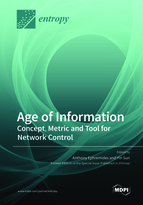Age of Information: Concept, Metric and Tool for Network Control
A special issue of Entropy (ISSN 1099-4300). This special issue belongs to the section "Information Theory, Probability and Statistics".
Deadline for manuscript submissions: closed (9 October 2022) | Viewed by 30539
Special Issue Editors
Interests: information theory; communication theory; multi-user systems; communication networks; satellite systems; systems theory; stochastic systems; optimization; signal processing; wireless communications; age of information
Special Issue Information
Dear Colleagues,
The concept of information freshness has developed over the last few years into an active and rapidly growing area of research. It has become known as the Age of Information (AoI). After its initial formal introduction, it became clear that it was very relevant (if not crucial) for numerous applications, ranging from autonomous vehicle systems, internet of things, real-time computing to database access, caching, and wireless communications. More importantly, the combination of transmission delay and sampling rate that are involved in the formulation of the AoI concept made it clear that there are far-reaching consequences in the relationship between signal processing, information theory, and control theory at a fundamental level.
In this Special Issue, we aim at attracting contributions that span the full range of applications and theoretical foundations of the AoI concept, which, in fact, is also a performance metric and an analysis tool. Of special interest is the role of AoI in bridging different disciplines and the use of AoI in the analysis and optimization involved in important applications.
Prof. Anthony Ephremides
Prof. Yin Sun
Guest Editors
Manuscript Submission Information
Manuscripts should be submitted online at www.mdpi.com by registering and logging in to this website. Once you are registered, click here to go to the submission form. Manuscripts can be submitted until the deadline. All submissions that pass pre-check are peer-reviewed. Accepted papers will be published continuously in the journal (as soon as accepted) and will be listed together on the special issue website. Research articles, review articles as well as short communications are invited. For planned papers, a title and short abstract (about 100 words) can be sent to the Editorial Office for announcement on this website.
Submitted manuscripts should not have been published previously, nor be under consideration for publication elsewhere (except conference proceedings papers). All manuscripts are thoroughly refereed through a single-blind peer-review process. A guide for authors and other relevant information for submission of manuscripts is available on the Instructions for Authors page. Entropy is an international peer-reviewed open access monthly journal published by MDPI.
Please visit the Instructions for Authors page before submitting a manuscript. The Article Processing Charge (APC) for publication in this open access journal is 2600 CHF (Swiss Francs). Submitted papers should be well formatted and use good English. Authors may use MDPI's English editing service prior to publication or during author revisions.







